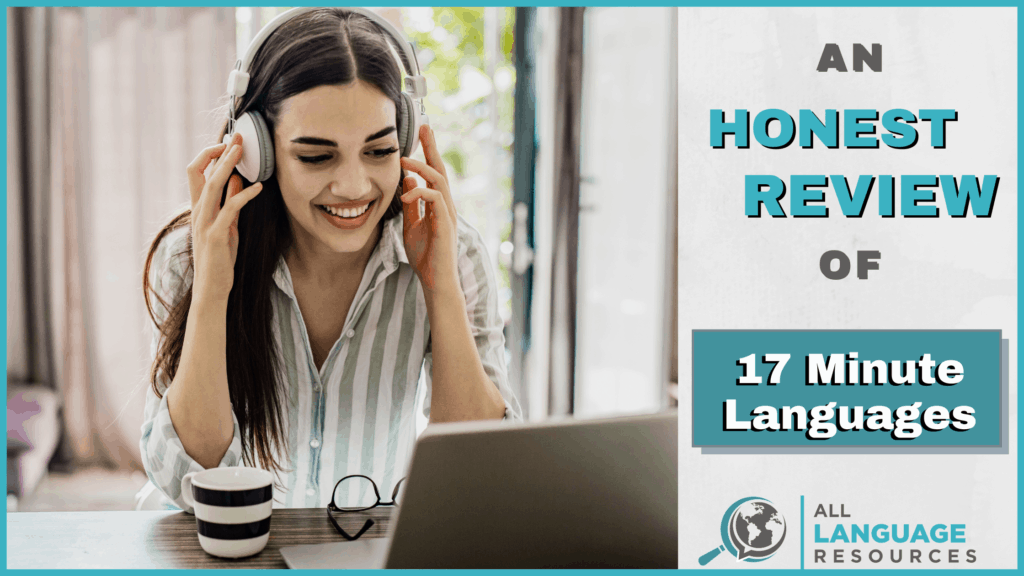17 Minute Languages

Summary
17 Minute Languages is a language-learning program that uses spaced repetition and native-speaker audio to teach a wide variety of languages. In our opinion, the courses aren’t very engaging; the courses we tried included significant errors and didn’t offer any language-specific explanations. There are leaderboards for comparing your progress with other users and a language forum that’s available after four days of use.
Native speaker audio is the only thing that impressed me in the courses I tried; mistakes and glitches were many.
Explanations are lacking, which I found made some material misleading.
I think there are far better ways to spend your time and money studying a language.
I Like
- It uses native-speaker audio.
I Don’t Like
- I came across several bad translations.
- I didn’t find any helpful explanations.
- Site navigation wasn’t easy or enjoyable for me.
- I didn’t find the exercises engaging.
Price
The Beginner’s Course is $59.95 and the Complete Package is $97. For the whole package and all languages it is $197. There is a free 48-hour trial.
Superlearning technology? Fluency in 50 hours? Courses in 80 different languages? This is either the greatest language-learning resource of all time or it’s a painfully overpriced language site making absurd claims. Let’s find out.
Contents

I was initially hoping this was a platform teaching 17 tiny languages, but the lack of hyphen in the name seems to merely be an odd stylistic choice. Instead, the program claims to be able to teach users a language in just 17 minutes a day.
For this review, I took advantage of the free trial courses for three languages, Spanish, Albanian, and Japanese. I also participated in demo lessons for Icelandic and Japanese, which is where most of the screenshots in this review come from. I’m fairly advanced in Spanish and a beginner in both Albanian and Japanese.
I currently live in Albania and have found precious few quality online resources for learning the language, so I was hoping to add this to my study plan. I chose Japanese to see how the platform handles teaching a different writing system and because I have an interest in the language.
My opinion after testing the program, unfortunately, is that 17 Minute Languages offers very little for the money it charges — it isn’t a resource I’ll be using or recommending in the future.
Getting Started
There’s a lot of text on the 17 Minute Languages Albanian page. It’s fairly chaotic and busy, and the text is primarily describing what the course offers and why you should buy it.

This dubious list of claims immediately set off alarm bells for me — “unique long-term memory learning method,” “superlearning [sic] technology,” “Albanian on autopilot.”
My suspicion that they were playing up the use of a Spaced Repetition System (SRS) and trying to pass it off as “unique” and “super” was quickly confirmed.
SRS is effective, and it’s great that they’re using it, but it’s not at all unique or special. Frankly, I expect to see it in any decent memorization tool, and a lot of free language resources implement the technology.
Anyway, I pushed on with waning reserves of optimism and signed up for some free trials.
Special Features
Opening a course for the first time takes you through a very short tour of the platform, which you can experience for yourself in a free demo course. To access the free demo without providing information, click on the tiny text I’ve circled in blue on the free trial registration page:

After brief explanations of the types of activities you’ll be doing, you’ll hear about the leaderboard feature and super-learning music.
The leaderboard feature is really basic — essentially, you earn points by completing exercises and can view the progress of other users.
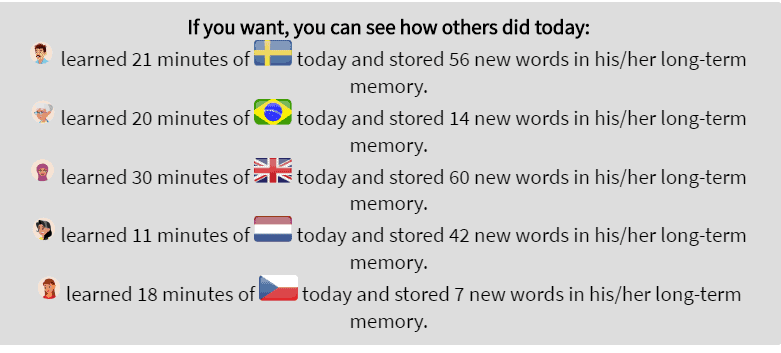
It isn’t very interesting, and I didn’t find it motivating at all.
The super-learning music aspect of the platform is a quirky touch that I would actually like if they didn’t hype it up so much.

This is where they get their “learn 32% faster” figure. Binaural Beats are a real thing, and they’re pretty interesting, but you can also find an abundance of listening material for free on Youtube.
Placement Test
After the quick tour of the course features, you get to take a placement test. Here’s the assessment for the demo Icelandic course:
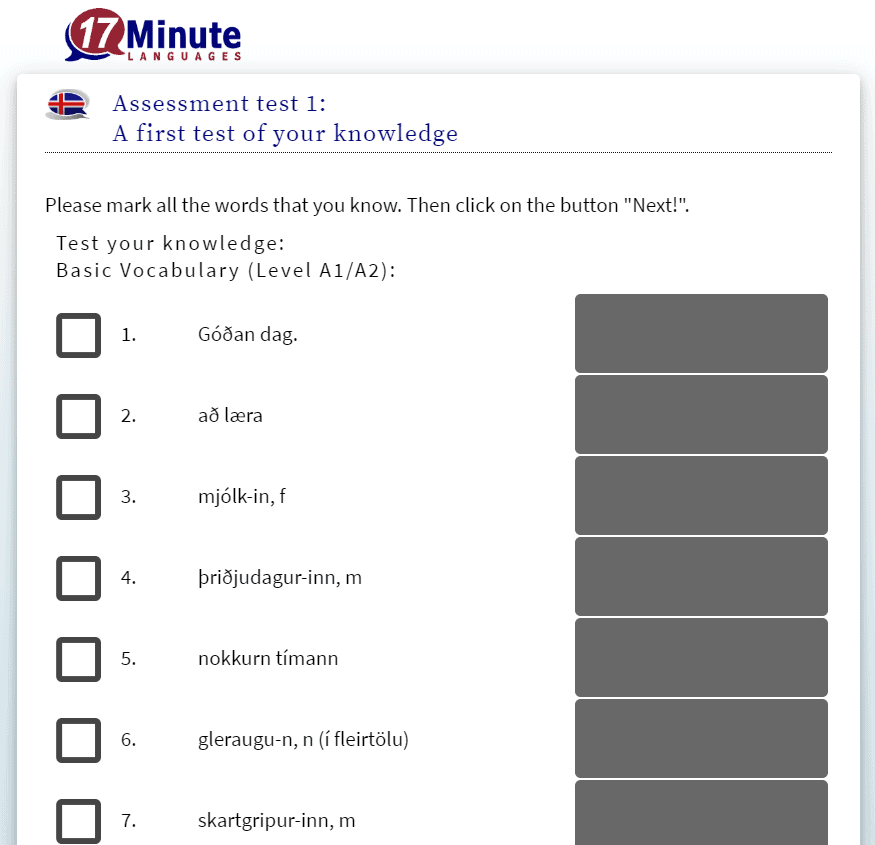
It’s very simple — select the words you are familiar with. Selecting the grey squares on the right reveals the English translation. There are roughly thirty of these questions, all of the same type.
My results for the Spanish placement test showed my level as just above C1 and that I know approximately 4300 words.
A paragraph summarizing my results also contained both, “Your vocabulary is quite extensive,” and “Your vocabulary is basic…” as well as “We suggest you start with the advanced course” and “…we suggest that you start with lesson 1.”
My best guess is that the trial course is only the Beginner’s Course and that the placement test doesn’t really apply to the free trial. In any case, I started with lesson one.
Exercises and Layout
The home page of a language course gives you access to the daily tasks and the option to practice tasks out of sequence.

I started with the daily tasks to get what seems like the prescribed experience, choosing the 17-minute study option to take advantage of the super-learning technology.
Flashcards
One of the main exercises you’ll do is a simple flashcard activity. Click the eye icon up top to see the translation, and then indicate whether you knew the correct answer or not.
You get to listen to the word or phrase in your target language spoken by a native speaker, which is one of the very few things I liked about the program.

The picture above is indicative of the majority of the pictures, often ambiguous and uninteresting.
There’s a similar exercise that has you choose between four optional translations of a word. Sometimes there are pictures, sometimes there aren’t.
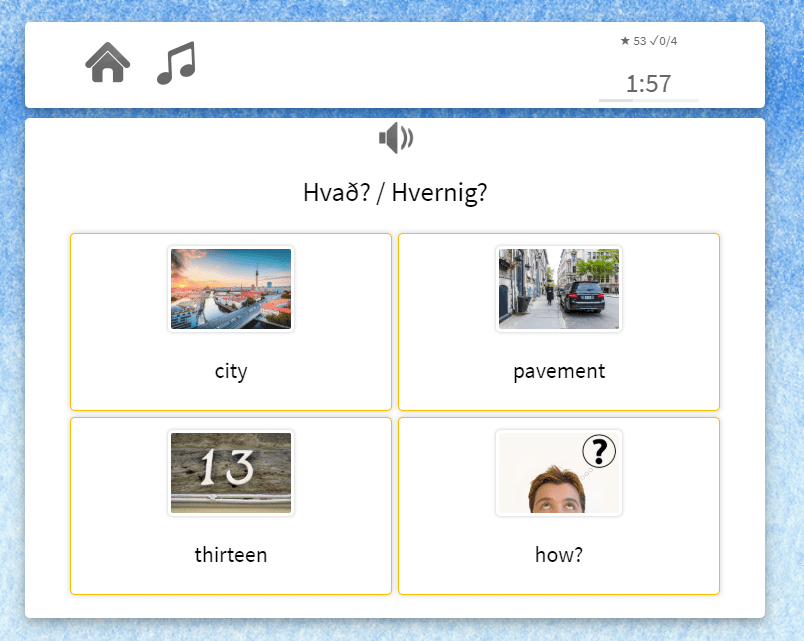
These exercises are very straightforward, but I noticed a number of problems.
There aren’t enough explanations – the following image depicts an instance in which the beginner learner likely needs an explanation.
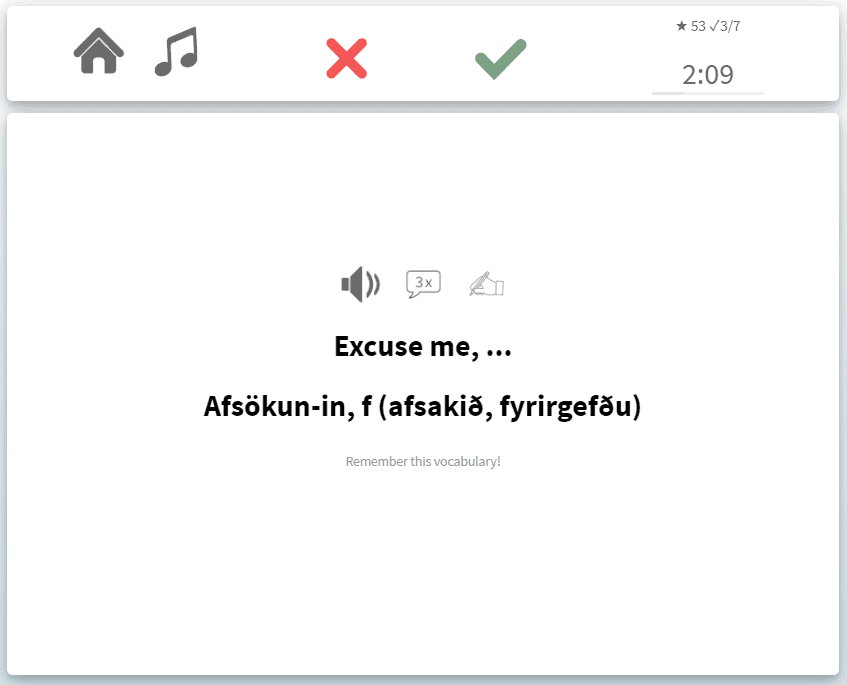
What’s going on here? I came across this flashcard after only a couple of minutes in the Icelandic demo. I have no idea what the Icelandic in parenthesis means or how to use the phrase.
There are questionable translations – Instead of learning “man” and “woman,” you’ll learn “husband” and “wife.” This might work for some languages, but definitely not for all.
For example, you can use hombre and mujer for “husband” and “wife” in Spanish, but it makes much more sense to learn these words as “man” and “woman” at first, as they are the primary meanings of the words.
You also come across phrases like “to spend” or “how long,” where the English phrases can have different meanings based on context that doesn’t necessarily translate. The phrases “to spend time” and “to spend money,” for example, require different verbs in Spanish, but 17 Minute Languages only gives you one and doesn’t tell you which.
These and other inconsistencies made me doubt the material and are why I never felt like I could trust the course.
Dialogue Text
This exercise presents a dialogue between two people. You can read and listen to the dialogue piece-by-piece, checking the translations as you go.
There was no way for me to actively interact with the dialogue; it was a purely passive exercise. It was nice to see the language in the context of a conversation, but I think it’s too much too fast without any explanation.
I found the Spanish dialogue texts to be better than the Albanian, but the Japanese version was worse.
I was able to listen to the audio of the conversation and see the English translation, but the Japanese text was simply absent. I experienced several small glitches like this during the trials.
The dialogue and vocabulary are the same for all the languages I tried, meaning cultural significance and context doesn’t play much of a role. I think this keeps the material from giving you truly good insight into what it’s like to use a language.
Verb Trainer
The verb trainer is the only way I saw the program attempt to teach verb conjugation. It’s not worth much in my opinion.
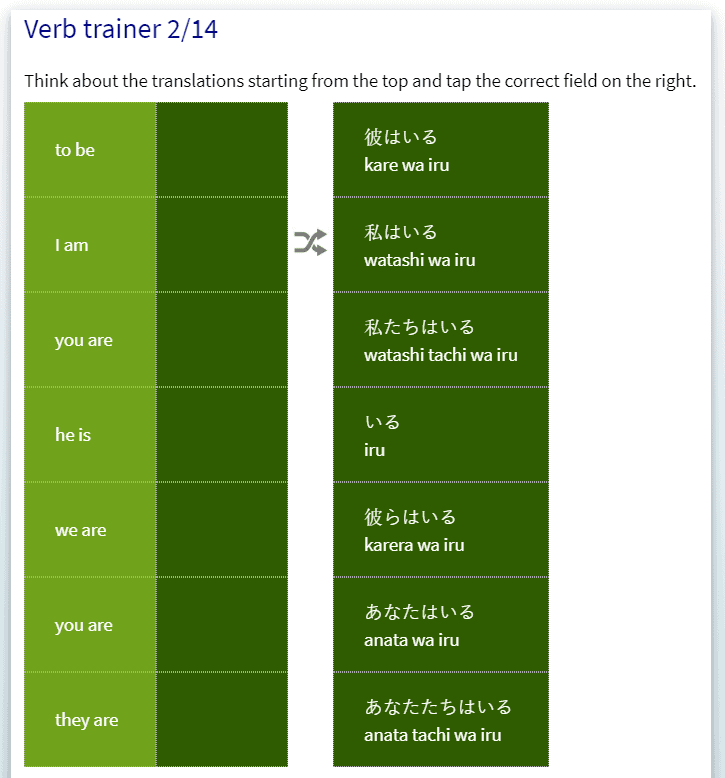
Here you can see the translated verb forms by selecting the empty boxes, and that’s it. This is from the demo for Japanese, a language without verb conjugations. For languages with conjugations like Albanian and Spanish, the approach is the same.
Aside from a simple matching activity that happens later on, there’s no other guided way to practice the verbs. There is also no explanation for why there are two “you” pronouns. I’m assuming the second one is plural, but I shouldn’t have to guess.
The Spanish course was also lacking the formal “you” pronoun.
I imagine trying to figure out and memorize verb conjugation this way would take forever. I think learning the rules and patterns for conjugation explicitly makes far more sense.
Sentence Builder
This is what 17 Minute Languages calls its “relaxed and creative way” to learn how to build sentences. It involves putting words in the right order to complete a sentence.
You can see an English translation of the sentence and listen to the sentence in your target language. This is a decent listening exercise, but nothing special.
The version of the sentence builder that’s available in the Japanese demo is even more basic:
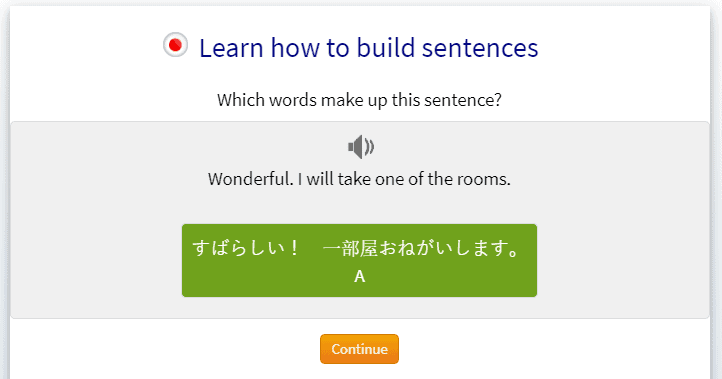
The feature includes example sentences with audio and a translation, which I think hardly makes for quality instruction on how to create your own sentences.
Audio Trainer
The Audio Trainer shows up after completing a study session as a way to review the words you’re learning.
It’s a way to listen to all of the words you didn’t know in the study session and to see their translations. I do like that you can see the words you need to practice grouped together here.
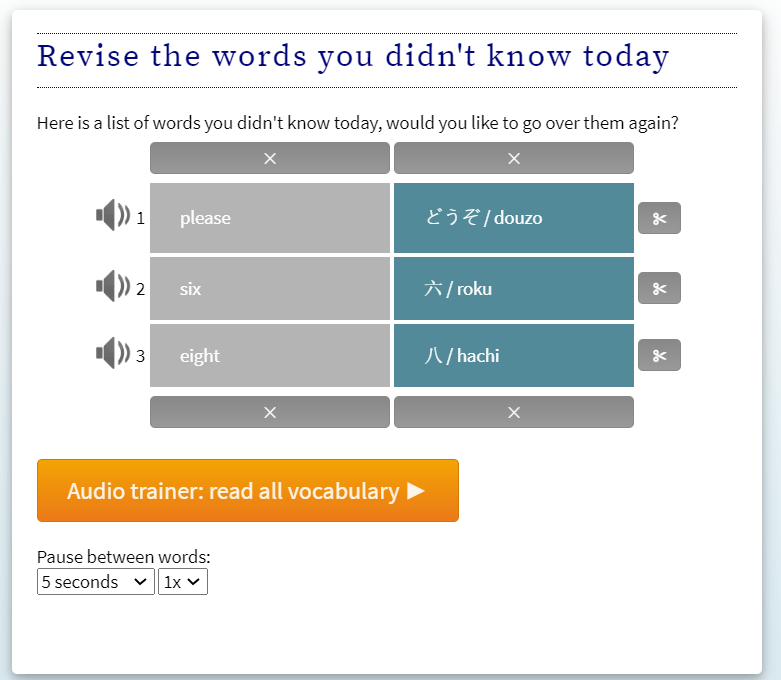
The audio trainer will auto-play the words in order, starting with the English translation and then the target word or phrase. This is good for testing yourself on being able to produce the word without reading it.
In the Albanian course, although the English text said, “upstairs” and “downstairs,” the audio read “above” and “below.” The same happened for “man” instead of “husband” and “woman” instead of “wife.”
These little mistakes pile up very quickly! It’s too hard for me to justify spending money on a resource that doesn’t seem like it was built with care.
Learning Japanese with 17 Minute Languages
I tried out the Japanese course to see if it bothered to teach users Hiragana and Katakana — it doesn’t.

You’ll jump right into learning words and phrases and can toggle the romanization on and off.
I didn’t find any explanations for the writing system in the course, but I did find this blog post on the 17 Minute Languages website giving some basic information on the language and its writing system.
Beginners of Japanese should definitely look elsewhere, especially with any desire to learn the writing system.
Forum and Learning Community
Access to the 17 Minute Languages Forum is only available after you’ve used the platform for four days, so I wasn’t able to access it with any of the trials I tried. Allegedly, the forum is a great place for networking with others and exchanging ideas.
There are also Meetups that happen on the first Tuesday of every month, but it’s not clear in which cities this actually happens.
I think the program itself might describe the Learning Community best:

Ok, I’m not exactly jumping up and down for the chance to compare how many words I’ve studied each day with someone, and I’m not sure how this accomplishes anything the leaderboard doesn’t, but maybe it makes more sense in practice.
Pricing
There are two course purchase options: the Beginner’s Course and the Complete Package, costing $39.95 and $97 respectively. You can also sign up for a free 48-hour trial.

If for some reason you’re seriously considering this resource, be sure to sign up for the free trial before buying. I was offered a significant discount immediately after signing up for the trial course.
There was a timer that accompanied this offer, indicating that less than 20 minutes to take advantage of it. This timer appears after you’ve registered for the free trial but haven’t had any time to try it out. The deal was also available to me for days after this timer expired.
Pressuring people to buy your product like this feels desperate and isn’t cool.
Alternatives
There’s no shortage of SRS-based flashcard programs online, which is essentially what 17 Minute Languages is. There are some free options (especially for popular languages), there are less expensive options, and, in my opinion, there are many that are simply much better.
If You’re Learning a Popular Language
For languages with lots of learners (think Spanish, Chinese, French, German, Japanese, etc.), there are a ton of good options. It just doesn’t make a lot of sense to go with 17 Minute Languages if you aren’t learning a less common language.
Babbel is a platform that offers comprehensive instruction, with explanations, varied practice activities, and well-structured courses.
There are a number of other language learning apps that can help with nearly every part of language learning.
These are just a couple of the many choices available. In the table below, you’ll find some of our top choices for those learning a more popular language.
If You’re Learning a Less Popular Language
It’s true that there are fewer options out there for learners of less common languages, but I think it’s worth looking for less expensive and better resources before settling on 17 Minute Languages. Here are some quality alternatives worth investigating.
Memrise
Memrise has a ton of content for free, mostly user-created. It’s a great place to go for building your vocabulary at no cost and in almost any language. It’s also fun to use and has a good mobile app.
Not all user-created courses have native-speaker audio, but the official Memrise courses have quality audio, images, and sometimes videos. Here’s our review.
Anki
This is another quality resource for SRS vocabulary practice. It’s lightweight, powerful, and totally customizable. If you’re willing to collect the material, you can make study decks for any language.
It’s got some pre-made decks for those that don’t want to spend time creating their own and is available free everywhere except the Apple Store, where it costs $25.
Duolingo
Frankly, I didn’t find 17 Minute Languages fun or easy to use. Duolingo has its limitations, but it’s free, offers courses in a ton of languages, and is high on gamification. Check out our Duolingo review.
Clozemaster
Another one that uses gamification and offers content in a lot of less common languages, Clozemaster is a fun way to learn a bunch of vocabulary using context sentences and spaced repetition. Here’s the review.
italki
This platform is a gem. It’s an online directory of tutors covering a massive range of languages that also offers some extra community features for free. It can be hard to beat one-on-one instruction from a native speaker. Read our review.
Pimsleur
This program has been around forever, and it can be a good place to get native-speaker audio lessons in some less common languages. The Albanian material, for example, is much better here than with 17 Minute Languages in my experience. You’ll get lots of listening and speaking practice and will interact with the language as it is actually used. This is our review.
Mango Languages
This is a good place for beginners to get practice, especially if learning a less common language as it teaches over 70. It isn’t a good option for higher-level learners or for writing and grammar, but it does cover some cultural information and grammar points. We tested it and wrote this review.
Haven’t found what you’re looking for? Glossika, Mondly, and uTalk are all resources that offer content in a bunch of languages and could be worth looking into even if they aren’t our favorites for more popular languages.
If self-directed study interests you, the Live Lingua Project is a library of free resources in over 150 languages. There are audiobooks, ebooks, and content from the Peace Corps and the U.S. Department of Defense.
Final Thoughts
The resource seems to be one of several that are cashing in on the ability to churn out identical courses in as many languages as possible. This can lead to mistakes, bad translations, and cultural insensitivity that negatively affect how well you can learn a language.
To give them their due, it’s cool that all of the courses use native-speaker audio. For people studying less common languages, it can be hard to find good audio, especially for the range of words covered by 17 Minute Languages.
Unfortunately, the uncertainty with the quality of the material outweighs the benefit of native-speaker audio for me, especially for the price.
In summary: stay away from this resource if you’re learning a more popular language, and don’t blindly assume the material is trustworthy if you insist on using it.
There are mountains of good resources out there, but the best are often designed specifically for one language. Find the language you’re learning in the table below to see the ones we rate highest.

